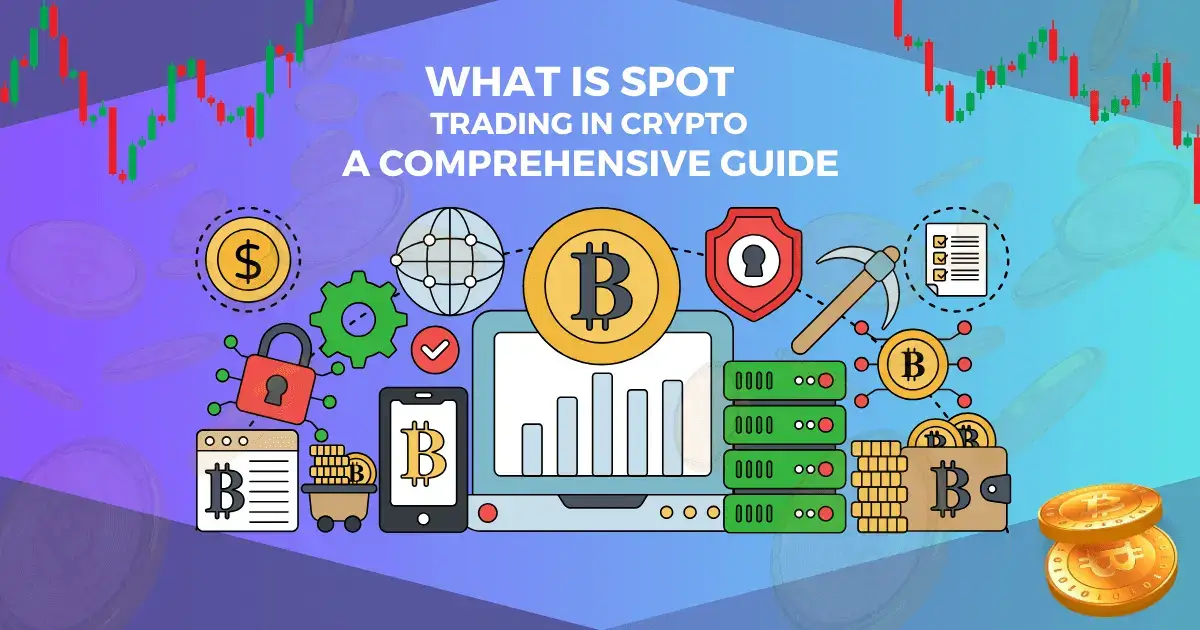Exploring the ever-changing realm of cryptocurrency, spot trading emerges as a fundamental approach for lovers to interact with virtual assets. This article serves as a complete guide, unraveling “What is spot trading in crypto”, from its definition to its importance inside the crypto marketplace.
What is Spot Trading in Crypto?
In its middle, spot trading includes the instantaneous purchase or sale of cryptocurrencies for prompt shipping and agreement. Unlike futures trading, it facilitates the direct trade of belongings between buyers and dealers at the contemporary marketplace price, making transactions speedy and green.
Definition of Spot Trading
Spot trading is the real-time execution of transactions, emphasizing immediate settlement. Traders buy or sell cryptocurrencies, ensuring a brief and straightforward method occurs immediately” without the complexities of futures contracts.
How Does Spot Trading Work?
Operational at the precept of instantaneous execution, spot buying and selling allow participants to buy or promote cryptocurrencies at the winning marketplace price. This actual-time alternate ensures that transactions are settled promptly, improving the trading system’s performance.
Why is Spot Trading Important in Crypto?
In crypto, spot buying and selling are paramount for diverse motives. Liquidity, a key component, ensures that belongings may be sold or offered, minimizing price slippage. Additionally, spot trading contributes to fee discovery, reflecting the most updated marketplace sentiment.
Liquidity in Spot Trading
Spot trading’s importance is underscored by its liquidity, which facilitates seamless transactions without extensive charge slippage. The crypto marketplace’s liquidity ensures buyers can execute transactions efficiently, contributing to the overall dynamism of the digital asset landscape.
Price Discovery
Another vital thing about spot buying and selling is their function in rate discovery. Transactions happening in real-time contribute to setting up a cryptocurrency’s present-day marketplace cost. This procedure provides treasured insights for investors, assisting in knowledgeable choice-making.
Spot vs. Futures Trading
Spot trading diverges from futures buying and selling in fundamental ways. While spot transactions involve immediate settlement and possession of the underlying asset, futures contracts entail agreements to purchase or sell belongings at a predetermined fee and future date.
Key Differences
The critical variations between spot and futures buying and selling lie within the immediacy of agreement and possession. Spot buying and selling offers a direct alternative to assets, even as futures trading entails agreements for destiny transactions, introducing additional complexities.
Which is Better for Beginners?
Spot trading is frequently endorsed by beginners venturing into the crypto marketplace because of its simplicity. Direct involvement with actual belongings makes the mastering curve extra doable, even as futures trading includes complexities, making it more acceptable for skilled investors.
How to Get Started With Spot Trading
Embarking on spot buying and selling involves a step-by-step system, beginning with selecting a reliable cryptocurrency alternate. Protection, charges, and available cryptocurrencies should be considered while making this critical decision.
Choosing a Cryptocurrency Exchange
Choosing a cryptocurrency alternate is a pivotal step. Platforms like Coinbase, Binance, and Kraken, recognized for their reliability, safety, and various offerings, are popular among spot trading fans.
Setting Up Your Account
Once a trade is selected, the subsequent step is to create and verify your account. This entails supplying necessary personal information and finishing safety features to protect your property and ensure clean trading.
Making Your First Trade
Initiating a gap exchange includes deciding on the preferred cryptocurrency pair, entering the exchange quantity, and confirming the transaction. It’s critical to remember market traits, set realistic expectations, and method the primary trades with a mastering attitude.
Spot Trading Strategies
Spot trading strategies vary, catering to exclusive trading patterns and danger tolerances. The purchase-and-keep method makes a specialty of long-term value appreciation, even as day trading and swing buying and selling capitalize on short-term rate fluctuations, requiring specific ranges of dedication and marketplace evaluation.
Buy and Hold
The buy-and-hold strategy includes acquiring cryptocurrencies to retain them for a prolonged period. This strategy relies on the potential long-term fee appreciation of the assets, making it suitable for people with an affected person’s funding outlook.
Day Trading
Day trading is an extra-energetic strategy involving a couple of trades within a single day to capitalize on brief-term fee fluctuations. A successful day of buying and selling calls for regular market monitoring and brief decision-making.
Swing Trading
Swing trading targets capture price swings over some days or weeks. Traders examine developments and market dynamics to perceive opportune access and go-out points, making it an approach that requires a moderate degree of dedication and marketplace know-how.
Risk Management in Spot Trading
Effectively handling chance is an essential issue in successful spot buying and selling. Implementing stop-loss orders, position sizing and diversification tools helps mitigate capability losses and enhance universal portfolio balance.
Stop-Loss Orders
Implementing forestall-loss orders is a risk control method that robotically sells belongings if their charges fall below a distinct threshold. This facilitates limiting capacity losses and shielding the dealer’s investment.
Position Sizing
Determining the proper length for every function primarily based on threat tolerance and typical portfolio length is crucial for powerful hazard management. Correct role sizing guarantees that losses are doable and do not disproportionately affect the general portfolio.
Diversification
Diversifying a portfolio across one-of-a-kind cryptocurrencies is a risk management method that reduces exposure to men’s or women’s assets. This technique allows the spread of chance and enhances typical stability in market fluctuations.
Tax Implications of Spot Trading
Understanding the tax implications of spot trading is crucial for compliance. Reporting gains and losses appropriately is vital, and buyers must maintain specified data in their transactions, considering that tax guidelines may also range by jurisdiction.
Reporting Your Gains and Losses
Accurate reporting of profits and losses is critical for tax functions. Traders should preserve certain information in their spot trading activities, including transaction dates, quantities, and expenses. Consultation with tax professionals may be beneficial to ensure compliance with specific jurisdictional requirements.
Conclusion
In the end, spot trading in cryptocurrency offers buyers a proper and immediate way to engage with the crypto marketplace. Understanding its intricacies, from numerous strategies to risk control and tax implications, empowers individuals to navigate the crypto area confidently. As the crypto market continues to conform, spot trading remains a foundational pillar for those seeking to capitalize on the massive opportunities within the digital asset realm.








